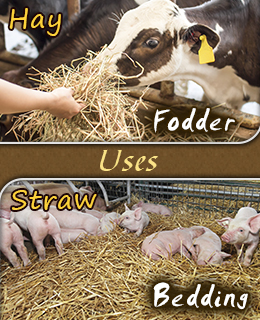Although used quite interchangeably, the terms hay and straw are different from each other in many aspects, primarily in their uses. Buzzle elaborates on the differences between these two similar looking agricultural goods.

Did You Know?
Hay is not preferred for mulch, as it might contain seeds that sprout up later on.
Actually going by the old idiom "Hay is for horses", we should not be really wondering about the differences between the words 'hay' and 'straw'. True! The idiom has got nothing to do with a horse's food, but it was just a quick reply to anyone saying "hey", suggesting that the word should not be used. Anyway, the fact remains that we do often get confused about this sunny, yellow, dried stuff.
To start with, let's just consider that one of them (hay) is a food source, while the other (straw) is not. Hay bales and straw bales are used for various purposes. Many people, even those who are frequently required to use them, sometimes cannot make out the difference between qualitative hay and straw. Given below are some important distinctions that will help you figure out which is what.
Hay Vs. Straw
Hay can be referred to as grass that is mowed and dried to be used as fodder.
Straw, on the other hand, consists of the stalk, seed coverings, dried stems, or leaves that have been separated from seeds.
Definition and Description
◆ Hay is simply short grass. Some known varieties include the Timothy or Orchard grass, Clover grass, and the Alfalfa hay (a forage crop).◆ At the time of harvesting, seed heads of fully grown crops like wheat, oats, and barley are reaped.
◆ This grass is grown purposely until it reaches a proper height. It is then cut, before the stages of seeding, drying, and bundling as a nutritious food source.
◆ It is obtained after harvesting a crop. So hay contains grains and is finer than straw. It is a crop that is alive, thus often looks greenish in color. It is comparatively lighter than straw and has a fresh smell.◆ Straw bales are obtained from the remaining bare stalks of these crops. These stalks become dead, and are dried naturally as they lose moisture.
◆ Straw can be identified with its peculiar yellow shade, and would never be green. It is not very fine, as it is basically the raw stubs left over from plants.
Uses
◆ Primary use of hay is as fodder for animals. Hay is a nutrient-rich food source for horses, cows, goats, pigs, rabbits, and other animals.◆ Stubbles and shucks are cut and raked to even them out, and later formed into bales.
◆ Livestock owners are sold such qualitative fodder, for which they are ready to pay handsome prices.◆ Straw bales are mainly used as a bedding. Animal rearing and activities like dairy and poultry use straw bales on a large-scale to provide for good animal bedding. Chicken coop, horse barns, etc., are some examples; good straw is sold as a high quality bedding, like for race horses.
◆ Also, artifacts like baskets and hats are made from such dried stubble of crops.
Gardening
◆ If soil enrichment is the purpose, highly nutritious hay is preferred.◆ For simple purposes like covering the soil in a pathway, straw is utilized.
◆ In this case, moist and decomposed hay proves to be a rich source of organic elements to the soil.◆ Straw bales are also employed to control erosion and protect crops during winter.
◆ They are used as bedding in vegetable gardens to grow crops like tomatoes, peppers, and cucumbers.
Straw Bales for Insulation
Straw-bale construction represents another usage. It is either a part of structural elements, or it can be used as an insulating material, which helps maintain a thermal balance in homes. Straw bales are generally seen in natural buildings or in brown constructions. Cob wall construction, known to use inexpensive, fireproof, and earthquake-resistant materials, includes straw, along with lime, water, and soil.
A major issue with the stacking and storing of hay and straw bales is that of mold growing within them due to either the moisture already present in them or the weather. Maintaining good quality and moisture-free hay and straw bales requires them to be dried under the sun. This can be achieved by keeping the moisture content well below 20%; rather, it is mostly seen to be less than 10% in many good quality bales.
Sometimes, straw and hay are packaged similarly, or straw bales are deliberately named as hay bales. Hence, be careful and alert while shopping for good quality hay for your garden.






